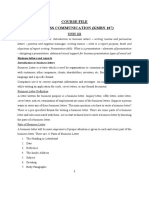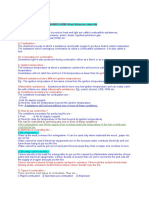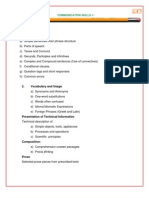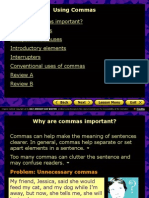Sample Business Letter.
Sample Business Letter.
Uploaded by
Vinod KumarCopyright:
Available Formats
Sample Business Letter.
Sample Business Letter.
Uploaded by
Vinod KumarOriginal Description:
Copyright
Available Formats
Share this document
Did you find this document useful?
Is this content inappropriate?
Copyright:
Available Formats
Sample Business Letter.
Sample Business Letter.
Uploaded by
Vinod KumarCopyright:
Available Formats
How to Write a Business Letter There are many different reasons for writing a business letter.
However, most business letters follow some general guidelines as described below. Difficulty Level: Average Time Required: 40 minutes
Here's How: 1. Use block style - do not indent paragraphs. 2. Include address of the person you are writing to at the top of the letter, below your company address. 3. After the address, double space and include date 4. Double space (or as much as you need to put the body of the letter in the center) and include the salutation. 5. Include Mr. for men or Ms for women, unless the recipient has a title such as Dr. 6. State a reference reason for your letter (i.e. "With reference to our telephone conversation..." 7. Give the reason for writing (i.e. "I am writing to you to confirm our order...") 8. Make any request you may have (i.e. "I would be grateful if you could include a brochure..." 9. If there is to be further contact, refer to this contact (i.e. "I look forward to meeting you at...") 10. Close the letter with a thank you (i.e. "Thank you for your prompt help...") 11. Finish the letter with a salutation (i.e. "Yours sincerely,") 12. Include 4 spaces and type your full name and title 13. Sign the letter between the salutation and the typed name and title
Tips: 1. Keep the letter brief and to the point 2. Do not use shortened verb forms - write them out (i.e. "don't instead of do not") 3. Always keep a copy of correspondence for future reference
IN SEARCH OF A LOST ART: HOW TO WRITE A BUSINESS LETTER
EACH YEAR I SEE THOUSANDS OF LETTERS. Many are written to me to ask the Academy for something as simple as a publication or to seek employment. Many more are written in support of someone applying for some honor or award. Although most of these letters should follow the format of a standard business letter, many of them only vaguely resemble what is expected. Many are missing one or more of the following elements considered essential for standard business letters: letterhead (or heading with a typed name, address and phone number), date, inside address, salutation with proper punctuation (a colon :), body (text), complimentary closing with proper punctuation (a comma,), signature, and a typed name. The layout of the letters, that is, their visual appeal and balance is even worse. I have been prompted to prepare this guide out of total frustration after seeing a continuing decline in the art of writing a business letter. Actually THE LETTERS that compelled me to write this guide were received from high school teachers of English, journalism, mathematics, and science and from a businessperson who wrote in support of students applying to become members of Ohio's Space Scientists of Tomorrow. Variously missing from their letters were headings, dates, inside addresses, salutations and complimentary closings. And the forms were disheveled. I have always thought that letter writing was taught in elementary school and reinforced by practice through ALL grades, including college. Frankly, in terms of form, often I am unable to distinguish any discernible differences between letters written by students, their teachers and by many other professionals. I'll admit that, in general, letters from businesses and government, while often wordy and vague, are usually in proper form, probably because of the communication standards imposed by employers. Apparently, for many, the art of writing a standard business letter has been lost. Thus, on the back I have outlined what are considered essential elements for a standard business letter. Use this guide yourself. Copy it for your friends. Give it to every teacher and student you meet. Maybe, together, we can resurrect the lost art of writing a business letter.
See Parts of a Business Letter
LYNN E. ELFNER Chief Executive Officer The Ohio Academy of Science November 1993
Letter Head or Typed Heading
The Ohio Academy of Science MCO west IIIrd Avenue Columbia OH-40-455-2228 Fax or Phone___________
Date
January 10,2007 Mr. John M Smith Chief executive officer Faith Ville Corporation 13 Easy Street Faith Ville OH-21234 Dear Mr. Smith,
Inside Address
Body text Salutation
This is the first line of first paragraph. It should state the purpose of the letter of the reasons for writing. This may be the only paragraph that gets read. Be brief and clear until you get it right. This is the second paragraph. Most letters have more than one paragraph. Although your letter should be more exciting to read than this one. It will not be well received unless it has all of the entire essential elements of a standard business letter. Heading date, inside address, salutation, body or text, complimentary closing your hand written signatures and your name typed below your signature. Although there are variations to these basic elements, including additional parts for special purpose, you can spend the rest of your life happily writing standard business letters if you get these basics right now. I am closing this letter now so that I can demonstrate the final elements of a letter. Thank you for considering these suggestions. Sincerely, ABC
Typed Name Complementary Closing
Signatures
(ABC) Chief Executive Officer
You might also like
- Engaging English Chapters Upto 12 ChapterDocument47 pagesEngaging English Chapters Upto 12 ChapterVinod Kumar44% (161)
- Essential & Non-Essential Parts of A Business LetterDocument3 pagesEssential & Non-Essential Parts of A Business LetterNabeel Yaqub90% (10)
- Basic Military Correspondence ModuleDocument13 pagesBasic Military Correspondence ModuleJaypee Masculino100% (3)
- Job Application FormDocument6 pagesJob Application FormSyed Hamza ShahbazNo ratings yet
- Chapter 7, The Appearance and Design of Business MessageDocument33 pagesChapter 7, The Appearance and Design of Business MessageRameez Ramzan Ali79% (19)
- The Rime of The Ancient MarinerDocument25 pagesThe Rime of The Ancient MarinerVinod KumarNo ratings yet
- Sach Thu Tin20102011 PDFDocument201 pagesSach Thu Tin20102011 PDFHạ VyNo ratings yet
- CH 2 Business Correspondence-I LetterDocument50 pagesCH 2 Business Correspondence-I LetterHossain UzzalNo ratings yet
- Business LetterDocument9 pagesBusiness LetterOmar N'chethaNo ratings yet
- Business LettersDocument34 pagesBusiness LettersAyush Astic100% (1)
- Letter of Enquiry - 12Document7 pagesLetter of Enquiry - 12ashia firozNo ratings yet
- Layout For Formal and Informal LettersDocument1 pageLayout For Formal and Informal LettersVlado NajdovNo ratings yet
- Business Letter WritingPPTDocument9 pagesBusiness Letter WritingPPTnohel010% (1)
- Types of LettersDocument12 pagesTypes of LettersHaseeb AhmedNo ratings yet
- Loan Application Consent FormDocument1 pageLoan Application Consent FormdemzkieNo ratings yet
- Headline ExpansionDocument4 pagesHeadline ExpansionVengat BalaNo ratings yet
- Letter of ComplaintDocument12 pagesLetter of ComplaintAscenNo ratings yet
- Suggest, Recommend, Propose, Advise, WarnDocument3 pagesSuggest, Recommend, Propose, Advise, WarnVăn minh tuệ LêNo ratings yet
- Types of Business LettersDocument20 pagesTypes of Business LettersLas Nieves NHSNo ratings yet
- Letter of EnquiryDocument5 pagesLetter of EnquiryCatalin Buhalau100% (1)
- Layout of A Formal LetterDocument3 pagesLayout of A Formal Letterchishan100% (1)
- Direct vs. Indirect SpeechDocument12 pagesDirect vs. Indirect SpeechTwyla BuenoNo ratings yet
- Unit 10 OfficeDocument6 pagesUnit 10 OfficeAlwi RafsanjaniNo ratings yet
- Business Letter: Syed Abbas Hassan GilaniDocument24 pagesBusiness Letter: Syed Abbas Hassan GilaniKh Furqan100% (1)
- Student's Material Lesson 3 of BCDocument9 pagesStudent's Material Lesson 3 of BCHelena CubiloNo ratings yet
- Notes Communication Skills Unit IIIDocument17 pagesNotes Communication Skills Unit IIIhimanshu.23bcon1056No ratings yet
- Letters and EmailsDocument9 pagesLetters and EmailsfrenzyNo ratings yet
- Makalah Business LetterDocument7 pagesMakalah Business LetterSepti ArlianitaNo ratings yet
- Business Letter in EnglishDocument12 pagesBusiness Letter in EnglishAngga Putra PratamaNo ratings yet
- Written Communication - IDocument33 pagesWritten Communication - IPOOJA BARSHINo ratings yet
- Technical Writing in Business CorrespondenceDocument82 pagesTechnical Writing in Business CorrespondencecheskajelcNo ratings yet
- Business Letters in English1Document28 pagesBusiness Letters in English1batgirl mihaNo ratings yet
- Business Letter Sample FormatDocument8 pagesBusiness Letter Sample Formatpdxdepckg100% (1)
- Letter Writing NotesDocument5 pagesLetter Writing Notessh4215862No ratings yet
- Format of A Formal LetterDocument12 pagesFormat of A Formal Letteramazonmarket755No ratings yet
- Business CorrespondenceDocument6 pagesBusiness CorrespondenceIMS AcadNo ratings yet
- Letter WritingDocument53 pagesLetter WritingAmpolu YayathiNo ratings yet
- ResumeeeeeeeDocument17 pagesResumeeeeeeeErla Ann Bangha-onNo ratings yet
- FYBMS Business Communication Unit 3 NotesDocument41 pagesFYBMS Business Communication Unit 3 NotesTitiksha JoshiNo ratings yet
- Writing Formal Letters and Applications Technical WritingDocument29 pagesWriting Formal Letters and Applications Technical WritingHamza ShabbirNo ratings yet
- Block Format: Letter Formats: Block, Modified Block, and Semi-BlockDocument7 pagesBlock Format: Letter Formats: Block, Modified Block, and Semi-BlockANGELICA GUIYAB100% (1)
- Wa0006.Document14 pagesWa0006.aaishaeducNo ratings yet
- How To Write A Good Business Letter by Sukh SandhuDocument106 pagesHow To Write A Good Business Letter by Sukh SandhuSukh Sandhu100% (1)
- Official Letter WritingDocument7 pagesOfficial Letter Writingeaglesniper008No ratings yet
- Materi Surat Resmi (Formal)Document5 pagesMateri Surat Resmi (Formal)Sufiarli GemilangNo ratings yet
- SBI PO :letter WritingDocument8 pagesSBI PO :letter WritingSahirNo ratings yet
- Business Letters (Format)Document28 pagesBusiness Letters (Format)EMBLAR ,JOHANNES RAY M.No ratings yet
- Formet of B LetterDocument12 pagesFormet of B LetterRAKIBUL ISLAMNo ratings yet
- About A Business LetterDocument5 pagesAbout A Business LetterikhlasNo ratings yet
- How To Write A LetterDocument5 pagesHow To Write A Letterpamela fernandezNo ratings yet
- Intended Learning OutcomesDocument20 pagesIntended Learning OutcomesAbiera Ronna MayNo ratings yet
- Business LetterDocument28 pagesBusiness Lettershahriaralif007No ratings yet
- Business LetterDocument34 pagesBusiness LetterJuber FarediwalaNo ratings yet
- Business WritingDocument22 pagesBusiness Writingmihir_shah_CENo ratings yet
- Businessletter 121216123347 Phpapp01Document73 pagesBusinessletter 121216123347 Phpapp01endNo ratings yet
- Lecture 01 (English For Employment)Document17 pagesLecture 01 (English For Employment)Shepherd ANGEL SarffNo ratings yet
- EnglishDocument27 pagesEnglishtatahNo ratings yet
- BcuDocument25 pagesBcuyadvendra dhakadNo ratings yet
- GE PC Module 8Document19 pagesGE PC Module 8Zedric MauricioNo ratings yet
- Clarity: What Are The 8 C's of A Business Letter?Document9 pagesClarity: What Are The 8 C's of A Business Letter?Lailanie NuñezNo ratings yet
- BC KMBN107 Unit 3Document26 pagesBC KMBN107 Unit 3Rizwan SaifiNo ratings yet
- Organisation and Techniques For Business LettersDocument23 pagesOrganisation and Techniques For Business LettersShubh Kirti AryaNo ratings yet
- Supplementary Notes On Written CommDocument15 pagesSupplementary Notes On Written CommMyUrielNo ratings yet
- Business LetterDocument21 pagesBusiness LetterFarash Muhamed100% (1)
- 08 Social Science History Key Notes CH 04 Tribals Dikus and The Vision of A Golden AgeDocument2 pages08 Social Science History Key Notes CH 04 Tribals Dikus and The Vision of A Golden AgeVinod Kumar67% (3)
- TNPSC StatisticsDocument74 pagesTNPSC StatisticsVinod KumarNo ratings yet
- 08 Social Science History Key Notes CH 04 Tribals Dikus and The Vision of A Golden AgeDocument2 pages08 Social Science History Key Notes CH 04 Tribals Dikus and The Vision of A Golden AgeVinod Kumar67% (3)
- DBA7102Document31 pagesDBA7102Vinod KumarNo ratings yet
- #Include #Include #Include: Int FloatDocument1 page#Include #Include #Include: Int FloatVinod KumarNo ratings yet
- He State Must Concur in The Application of Laws, Except Those That Pertain To Communications, Defence, Finance, and Foreign AffairsDocument2 pagesHe State Must Concur in The Application of Laws, Except Those That Pertain To Communications, Defence, Finance, and Foreign AffairsVinod KumarNo ratings yet
- QA Inspection FormatDocument1 pageQA Inspection FormatVinod KumarNo ratings yet
- Rank Cutoff For 2012-13Document1 pageRank Cutoff For 2012-13Vinod KumarNo ratings yet
- Transmission LineDocument23 pagesTransmission LineVinod KumarNo ratings yet
- Combustion and Flame Class 8Document4 pagesCombustion and Flame Class 8Vinod KumarNo ratings yet
- Dot and Stick DiagramDocument3 pagesDot and Stick DiagramVinod KumarNo ratings yet
- English CommDocument28 pagesEnglish CommVinod KumarNo ratings yet
- Safety Plan TemplateDocument2 pagesSafety Plan TemplateVinod KumarNo ratings yet
- Guru Tegh Bahadur Institute of Technology Electrical ScienceDocument7 pagesGuru Tegh Bahadur Institute of Technology Electrical ScienceVinod KumarNo ratings yet
- 16.category Cutoff R11final2012Document1 page16.category Cutoff R11final2012Vinod KumarNo ratings yet
- Data InterpretationDocument9 pagesData InterpretationVinod KumarNo ratings yet
- Different Page NumberingDocument5 pagesDifferent Page NumberingVinod KumarNo ratings yet
- Filling of Online MCD Property TaxDocument3 pagesFilling of Online MCD Property TaxVinod KumarNo ratings yet
- Argumentative Essay FormatDocument5 pagesArgumentative Essay FormatJasmine LooNo ratings yet
- IELTS General Task 1 - How To Write at A 9 LevelDocument53 pagesIELTS General Task 1 - How To Write at A 9 LevelTATHEER KHANNo ratings yet
- Paper Initial Salutation, Introduction and Final SalutationDocument21 pagesPaper Initial Salutation, Introduction and Final SalutationElsaNo ratings yet
- Type of Business Letter: For Example, Order Letters Have The Following PartsDocument3 pagesType of Business Letter: For Example, Order Letters Have The Following Partssaeed2525No ratings yet
- PCom - Lesson 16Document104 pagesPCom - Lesson 16Ron GruellaNo ratings yet
- A Handbook On Business Writing: L Tartu UniversityDocument53 pagesA Handbook On Business Writing: L Tartu UniversityForla MiNo ratings yet
- Mindmap Group 2Document4 pagesMindmap Group 2Alfata RFNo ratings yet
- M1 La1 Task 1-6Document9 pagesM1 La1 Task 1-6Ika SartikaNo ratings yet
- CommasDocument26 pagesCommasapi-261745805No ratings yet
- How To Write Informal Letters or EmailsDocument6 pagesHow To Write Informal Letters or EmailslauraNo ratings yet
- Early Childhood Cover Letter SampleDocument8 pagesEarly Childhood Cover Letter Samplegag0besuhez2100% (1)
- How To Write An Informal LetterDocument9 pagesHow To Write An Informal LetterDARIA DINCĂNo ratings yet
- Business Correspondence Style and Format: Theoretical & Applied Science September 2015Document7 pagesBusiness Correspondence Style and Format: Theoretical & Applied Science September 2015Reski Amelia Sm ChannelNo ratings yet
- Business Letter: Focus: - Mechanical Structure - Types of Business Letter - LanguageDocument36 pagesBusiness Letter: Focus: - Mechanical Structure - Types of Business Letter - LanguageNur Rizki ApriliyantoNo ratings yet
- MCRHRDTI MES Workbook2022Document17 pagesMCRHRDTI MES Workbook2022Hafiz NajeebNo ratings yet
- Formal and Informal LettersDocument12 pagesFormal and Informal LettersIleana DigaNo ratings yet
- Email WritingDocument6 pagesEmail WritingTharusha FernandoNo ratings yet
- 02 Forms of CommunicationDocument22 pages02 Forms of CommunicationSAJID HUSSAINNo ratings yet
- Parts of Business LetterDocument42 pagesParts of Business Letteraradata19No ratings yet
- WP Course 04Document12 pagesWP Course 04Robi Sixer AxialNo ratings yet
- Minggu Ke 9 TK 6 (Lay Out of Letter)Document5 pagesMinggu Ke 9 TK 6 (Lay Out of Letter)VinsNo ratings yet
- Giáo Trình Writing VstepDocument34 pagesGiáo Trình Writing Vstephieund030796No ratings yet
- Writing Your Formal EmailDocument5 pagesWriting Your Formal EmailchemamedinaNo ratings yet
- MB0039 SLM Unit 11Document18 pagesMB0039 SLM Unit 11Kamal RaiNo ratings yet
- Letter Writing Lesson PlanDocument8 pagesLetter Writing Lesson PlanIza TomNo ratings yet
- Anatomy of A Letter 1Document3 pagesAnatomy of A Letter 1apriele rose hermogenesNo ratings yet
- ENGL. 3 Module No.1 (Week 1)Document11 pagesENGL. 3 Module No.1 (Week 1)Kristelle Joy Ang MalayangNo ratings yet
- Formal and Informal Letter Kel 7Document9 pagesFormal and Informal Letter Kel 7Naajihah MafruudlohNo ratings yet












































































































